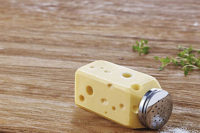
Using Chr. Hansen’s new and improved foil-ripening production method, producers of continental cheese types will be able to shorten production time and increase their yield significantly while preserving great taste and texture.
In collaboration, Chr. Hansen and a major European dairy have creatively refined the foil ripening production method. Supporting dairies in tackling the drawbacks of traditional foil ripening, this cost-attractive technique is applicable in manufacturing of sliced, grated or chopped continental cheese such as gouda and edam.
Key to the innovative sophistication of foil ripening is Chr. Hansen’s Flavor Control series of starter cultures that has been developed in co-operation with select European dairies providing input, guidance and feedback on the needs of the market.
Foil ripening implies wrapping the young cheese in foil and then storing it at 4-7°C while it matures. One advantage of ripening cheese this way is that the cheese does not lose moisture while maturing. By vacuum–packing the cheese in foil during ripening the producer avoids losing beneficial moisture due to evaporation and valuable cheese due to rind formation. Since the cheese is used in sliced, grated or chopped form, the rind is removed anyhow before further processing.
Another advantage of foil-ripened cheese is that it results in hardly any cheese loss when the cheese is cut into slices or bars. In comparison, the cutting loss in standard ripened cheese, referred to as “naturally ripened cheese” may be as much as 5-15%.
“A major challenge in traditional foil ripening is building satisfactory taste,” explains Anne-Claire Bauquis, market development engineer, ripening systems, Chr. Hansen. “Due to the different conditions in the vacuum-packed foil the flavor development often falls short.
“Chr. Hansen has cracked that nut. Our refinement of the foil ripening method is twofold: We suggest combining a Direct Vat Set starter culture with an adjunct starter culture with a higher proteolytic and peptidolytic activity and we propose storing the foil-wrapped cheese at 10-16°C for four to six weeks –one to two weeks shorter than in naturally ripened cheese.”
Bauquis continues: “In the quest for increased yield and shorter production time one has to be very careful not to jeopardize flavor development. By adding adjunct cultures the foil-ripened cheese will develop the same quality and flavor as in naturally ripened cheese.”
Chr. Hansen recommends that dairies use Chr. Hansen’s Flavor Control CR-500 culture series to restore a good flavor balance. The Flavor Control cultures work by speeding up the breakdown of compounds during the cheese ripening process and they are a perfect match to full-fat or reduced fat continental cheese free from bitterness.
“Using this method, producers of rindless cheese accelerate the ripening process while at the same time increasing yield – without jeopardizing the quality of the cheese,” says Soeren Herskind, marketing director, cheese cultures, Chr. Hansen. “Basically, industry-scale customer trials demonstrate that dairies are able to produce more cheese with great taste in shorter time.
“The refined foil ripening method produces an 8% upside on yield. At current rates this yield increase and the concurrent decrease in storage time at the dairy would add 1.5 m€ to the bottom–line of an average–size continental dairy producing 5.000 tons of cheese annually.”
Chr. Hansen
www.chr-hansen.com

